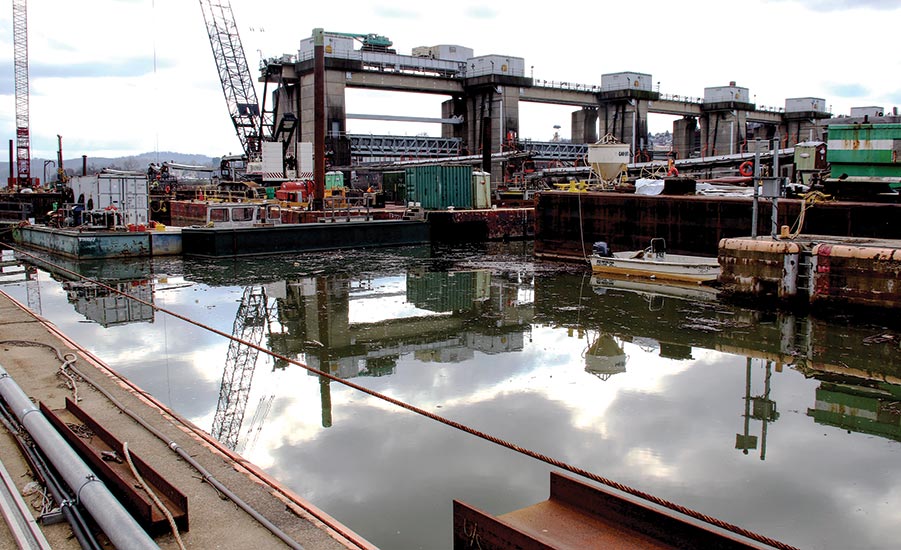With partisan squabbles over funds for President Donald Trump’s border wall blocking agreement on spending bills for fiscal year 2020, Congress again is turning to its usual Plan B: a stopgap bill to keep agencies’ programs, including construction accounts, operating.
Seeing the Oct. 1 start of fiscal 2020 around the corner, the House on Sept. 19 passed a continuing resolution, or CR, extending until Nov. 21. The vote was 301-123. In the Senate, Majority Leader Mitch McConnell (R-Ky.) said on Sept. 23 that he planned a floor vote on a CR within days. Funding generally would continue at 2019 levels. The task for Congress will be using the stopgap’s breathing room to strike a deal on final 2020 spending levels, including those for infrastructure programs.
Some signals are promising. The Senate Appropriations Committee on Sept. 19 cleared a bill funding Dept. of Transportation programs that includes $46.4 billion for the federal highway obligation limit. That’s up 2% from 2019 and the same sum the House included in the version it passed June 25. Those dollars come from the Highway Trust Fund and are distributed to states by formula.
Appropriators also are providing a bonus in non-formula, or discretionary, dollars for DOT. The Senate committee added $2.7 billion in 2020 discretionary dollars from the general fund for highways. That’s down 17% from 2019, but 54% above the House-passed number.
DOT’s popular BUILD, formerly TIGER, grants, another discretionary program, would get a boost of $100 million, or 11%, under the Senate committee and House bills. Discretionary airport grants total $450 million in the Senate panel’s measure; the House bill has $500 million, the same as the enacted 2019 number.
Transportation programs won large shares of the $10-billion hike in 2018 and 2019 for infrastructure programs in the budget agreement for those two years. But the follow-on budget deal for fiscal 2020 and 2021, enacted Aug. 2, didn’t specify a new infrastructure bonus.
Final numbers won’t be set for weeks. But Brian Deery, senior director of the Associated General Contractors of America’s highway and transportation division, is pleased with the discretionary DOT infrastructure dollars appropriators have in their 2020 bills so far. “It’s a gift,” he says. “It’s not money you can count on.”
The Army Corps of Engineers civil works program also is faring well in 2020 spending bills so far. The Senate committee’s bill for energy and water programs, passed 31-0 on Sept. 12, would provide $7.75 billion for Corps’ civil works. That’s a boost of $752 million, or 11%, over the enacted 2019 level. The committee’s $7.75 billion also exceeds the $7.36 billion for Corps’ civil works contained in the House-approved 2020 bill. The House version itself is about 5% above the 2019-enacted level.
John Doyle, special counsel with law and lobbying firm Jones Walker LLP, says of the Senate panel’s recommendations, “The Corps’ total civil works number is very, very strong.” The House and Senate bills also reject Trump’s proposal to slash 2020 Corps’ civil works by $2.2 billion, or 31%, to $4.8 billion.
Within the Senate committee’s civil works total, the Corps’ construction account would get $2.18 billion, a 28% boost over 2019, and nearly double the president’s $1.17-billion request. “A fantastic improvement there,” Doyle says.
One of the largest construction allocations in the Senate committee and House bills is $111 million to continue work on two new, larger locks at the site of present lock #4 on the lower Monongahela River at Charleroi, Pa. President Trump requested $55 million for the project.
Corps’ operation and maintenance work (O&M) would receive $3.8 billion under the Senate committee bill, up a modest 2% from 2019’s actual total. The Senate panel’s O&M number is 3% below the House’s $3.92 billion but well above Trump’s $1.93-billion proposal.
The American Association of Port Authorities welcomed the Senate panel’s civil works figures, says Jim Walker, director of navigation policy and legislation. He calculates that bill’s 2020 funding for coastal navigation projects at a bit above $3 billion. That, he notes, tops the House’s $2.5 billion and is more than double Trump’s request.





